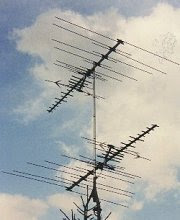 |
| Two antennas, one output |
Callos obviously googled the question and found the same answer the OQ found, a tutorial at the site TVAntenna.com (you will need to use archive.org to find it). The tutorial is almost 500 words long, but Alexander pared it down to about 280. Unfortunately, the journalism major didn't know what information to include and what to leave out. In other words,
"The formula for determining the minimum vertical spacing between the two antenna booms is a half λ (wave) of the lowest channel to be received. To calculate this distance take 467 and divide it by the lowest TV channel frequency that will be received by either of the two antennas. So for example, if the lowest channel received by either of the two antennas is channel 2, you would take 467 and divide it by the lower frequency of channel 2 (54 MHz). This would give you the minimum vertical spacing of 8.64 feet or 103.7 inches that would be needed between the two antenna booms..."in the original became
"The lowest frequency that will be received is 2. A frequency of 2 is equal to 54 megahertz. Divide 467 by 54 to get the proper distance the vertical antennas should be separated on the roof. In this instance the distance is 8.64 feet..."in what we'll call "Callos-speak." Alexander also managed to reduce
"There must also be the exact same length of coaxial cable between the two antennas and the combiner, which is basically a backwards two-way signal splitter. The same exact length of coax cable between each of the two antennas and the combiner is needed also to help prevent ghosting from occuring [sic] on the TV's [sic] connected to the antenna system..."to the less informative
"Connect the coaxial cable to both antennas. This cable must be the same length to prevent interference between the two antennas."We're not certain we'd call ghosting "interference," but hey – that's about the sum total of Alexander's knowledge. That's probably why he completely ignored suggestions for using a band-pass filter, a device with which we suspect he is completely unfamiliar.
copyright © 2017-2022 scmrak
DD - ELECTRONICS

No comments:
Post a Comment